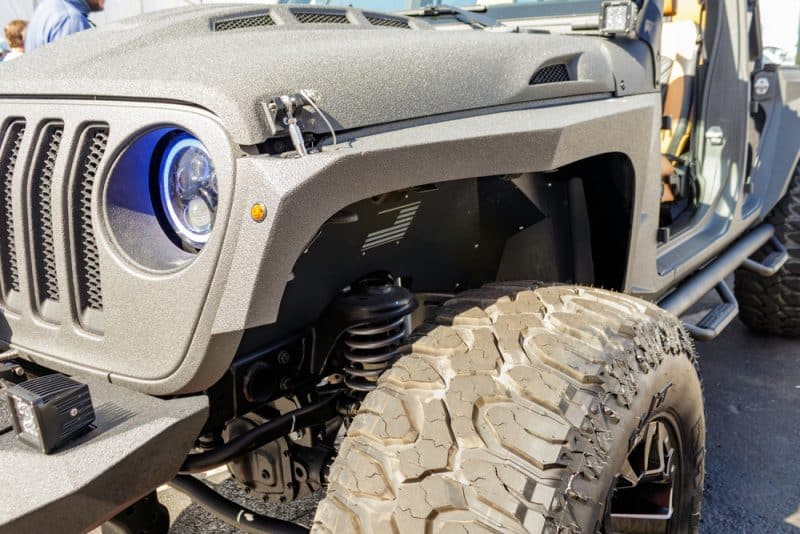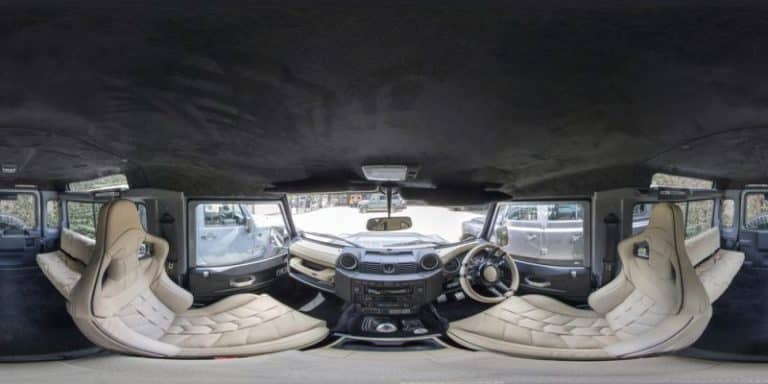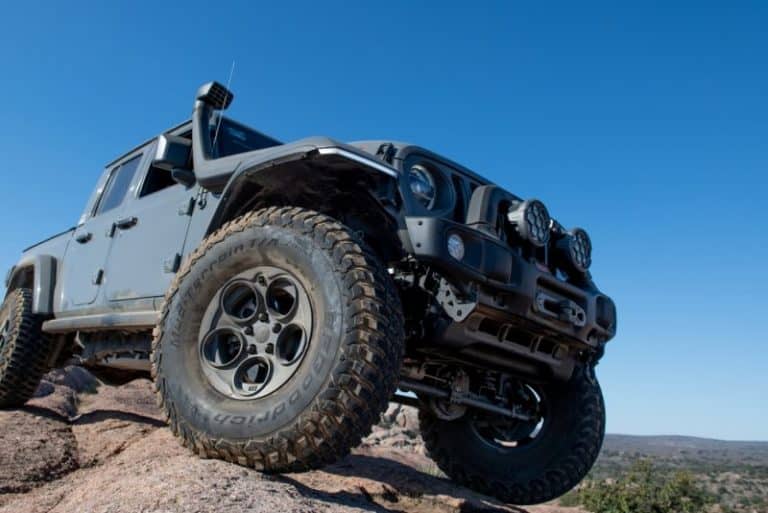How Do I Know If My Jeep Shocks Are Bad? (Must Read To Know)
When you drive with worn struts or shocks, you’ll get to experience a bouncier ride and put yourself and others in harm’s way.
But, of course, there are certain signs that you can pick up from bad shocks or struts.
This article outlines the telltale signs that indicate when your Jeep has bad shocks. So, read on!
If your Jeep has bad shocks or struts, it will bounce wildly when you climb road bumps. It’ll also make too much noise at potholes and road bumps. What’s more, you may notice unnecessary forward jerks or lurches whenever you apply the brakes or backward squatting when you accelerate. Furthermore, negotiating turns or curves becomes difficult as steering issues develop.
How to Tell if Shock Absorbers Need Replacing?

When your shocks or struts need replacement, they give you subtle signals that you need to pick up. Ignoring them is not wise as your safety is in the line.
Here are the most common signs that most car owners miss out on but that you won’t after reading this section.
#1. Bumpy Rides
This sign is the clearest hint indicating a need for immediate replacement of your shocks. If you miss this one, catching the others may be more difficult.
When you notice that your car isn’t giving you a comfortable ride as it normally does, you should start thinking in this direction.
You’ll feel it more when you hit a bump on the road and the drive seems rougher than usual. Also, the car bounces a lot and is highly unstable.
Furthermore, when you’re about to drive over or outmaneuver a pothole or bump, you may feel you’ll lose control of the vehicle.
That is one of the surest signs that your struts or shock absorbers need a change. You may also hear loud noises when you hit a road bump or enter a pothole.
#2. Steering Problems
This sign is another telltale signal of bad shocks or struts. You unusually find it difficult to steer your vehicle as the steering wheel feels hard and stiff to maneuver.
You may also feel the car leaning or swaying whenever you switch lanes or negotiate a turn. That is due to the car’s wheel alignment.
#3. Braking Problems
Worn shocks or struts lead to other problems besides suspension issues. That is because they are a structural component of the vehicle.
Hence, when the shocks become worn, other parts of the car also malfunction.
One other problem that may arise is complications with the brakes. Read more about Service Electronic Braking System.
You may observe that your vehicle makes a lurch forward whenever you apply the brakes, or the vehicle makes a nosedive. That makes the car unstable.
#4. Fluid Leaks
This sign is a common visual signal that your car has bad shocks and struts and needs a change. If you look at your shock absorbers, you may observe some elements of wear and tear.
#5. Unusual Wear of The Tire Tread
This sign is potentially dangerous, and you shouldn’t take it lightly. Once you detect this sign, you should schedule a visit to your dealership or your local mechanic.
What happens when your wheel alignment or suspension is off. You may observe that the tires undergo tread wear to look no different from an aging tire.
However, when you have a damaged suspension, scalloped dips or cups ensue, and it happens around the tread edge.
#6. Mileage
Once your Jeep reaches the mileage for scheduled maintenance, the shocks are probably bad already.
Your car should have its regularly scheduled maintenance done once it hits that specified mileage.
The value is usually 50,000 miles. The struts or shock should be replaced when your car reaches the stipulated mileage.
You can check your owner’s manual if you’re unsure about your vehicle’s maintenance mileage.
What Happens if Shocks Are Bad?
When your car has bad struts or shocks, you’ll find it difficult to maintain control of your car during driving sessions.
Therefore, you potentially place the people you are carrying and yourself in danger. You also place other drivers at risk of accidents.
Consequently, you should always check your shocks routinely to be in good working condition. When your car’s shocks begin to go bad, you’ll have instability on the road.
That is a result of poor control over the car. Sometimes, you may feel like the car is tipping in one direction.
Furthermore, your car tires may start bouncing after every bump or pothole. You may notice that the car’s front lurches forward when you apply the brakes at a slower speed.
The rear part of the car may also squat backward when accelerating. Also, you may notice an uneven tread with the tires.
I don’t recommend driving a car with bad shocks or struts. Technically speaking, you may be able to drive the vehicle, but that is a disaster waiting to happen.
If you drive a car with worn shocks or struts, I cannot guarantee your safety.
When you are going fast and entering a pothole or hitting a bump, you may lose control of the vehicle. Negotiating turns and curves become a problem as well.
More than that, when the weather condition is bad, there is an increase in the stopping time of your car. These problems will escalate as your car’s struts and shocks deteriorate.
Therefore, whenever you notice any of the bad shock signs mentioned above, it’s time you replace the shocks.
But, of course, you can always schedule a visit to your dealership or your local mechanic to carry out the shock or strut replacement.
Bad Shock Absorber Symptoms

When your vehicle’s shock absorber is bad, it produces some symptoms. Here’s a summarized list to run through:
- Your car makes unusual noises when it enters a pothole or hits a bump
- You have poorer control over your car, especially after negotiating bends and curves
- Your vehicle keeps bouncing after hitting a bump or entering a pothole
- You experience unusual forward lurches when braking
- You experience backward squatting of the car’s rear when accelerating
- You have steering wheel problems
You can perform a bouncing test on your car to test the shocks. To do this, apply pressure on each corner of the car by pushing directly down and hard.
If the corner continues to bounce, then you need to replace the shocks.
The shocks and struts are a fundamental unit of your car’s suspension. They perform similar functions even though they are different.
They minimize the springing movement of your vehicle and, as a result, halt the bouncing and oscillator movement of your vehicle.
That can damage the car’s underside and make it difficult to steer properly.
However, when both structures are in sync and working properly, you can steer easily, handle the car well, and enjoy a comfortable drive. Beyond that, you’ll feel your car wheels aligned perfectly.
It’s important to point out that your Jeep doesn’t have both a shock absorber and a strut. It either has a strut or a shock absorber, not both.
So even though some people use the terms interchangeably, there are subtle differences.
Shocks are simply shocked absorbers. Nothing more, nothing less. They provide better handling of your car.
On the contrary, struts carry out diverse functions as part of your vehicle’s suspension system.
They act as shock absorbers and also perform key roles in wheel alignment.
Struts also have other components like the coil spring, which is a part of the suspension system. Every time you replace your car’s strut, you’ll also need to realign the wheels.
Some cars with front suspension systems possess struts.
Furthermore, struts and shocks wear out gradually. As a result, you may not pick up the signs early enough as you get accustomed to the bouncier and looser ride quality.
For this reason and to prevent accidents, I recommend installing new shocks or struts periodically. You can do that after every 50,000 miles.
That coincides with the routine maintenance schedule for most vehicles.
You can confirm your car’s maintenance mileage from the owner’s manual and have the shocks replaced at the stated mileage.
You can replace bad shocks and struts at your dealership or any local mechanic.
Choosing the Right Shocks for your Jeep
Conclusion
Sometimes, knowing when your car’s shocks or struts are bad may be difficult because you get to adjust subconsciously to the bouncier drive.
However, when you notice that your car makes funny noises when you hit a bump or enter a pothole, it is time you replace them as it’s safer in the long run.
Of course, you can always test the effectiveness of your Jeep’s shocks through the bouncing test.






